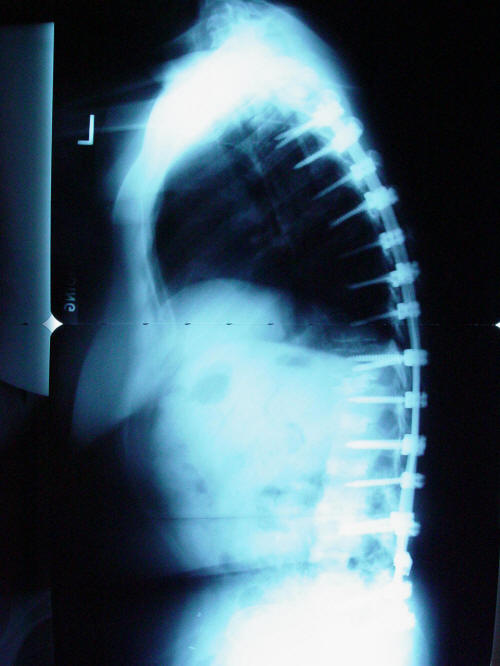Page 4 - Before And After X-rays
X-rays (or Rontgen rays) are a form of electromagnetic radiation with a wavelength in the range of 10 to 0.01 nanometers, corresponding to frequencies in the range 30 to 30 000 PHz (1 PHz = 1015 Hertz). X-rays are primarily used for diagnostic radiography and crystallography. X-rays are a form of ionizing radiation and as such can be dangerous. In many languages it is called Rontgen radiation after one of the first investigators of the X-rays, Wilhelm Conrad Rontgen.
They took x-rays before and after the operation to be able to see the actual angular difference.
Posterolateral fusion places the bone graft between the transverse processes in the back of the spine. These vertebrae are then fixed in place with screws and/or wire through the pedicles of each vertebrae attaching to a metal rod on each side of the vertebrae.
Interbody fusion places the bone graft between the vertebra in the area usually occupied by the intervertebral disc. In preparation for the spinal fusion, the disc is removed entirely. A device may be placed between the vertebra to maintain spine alignment and disc height. The intervertebral device may be made from either plastic or titanium. The fusion then occurs between the endplates of the vertebrae. Using both types of fusion is known as 360-degree fusion. Fusion rates are higher with interbody fusion. Sue had an interbody fusion known as Anterior lumbar interbody fusion (ALIF)- an anterior abdominal incision is used to reach the lumbar spine
Lateral View, Prior To The Operation
This figure is a lateral view before the operation and examined closely one can see the lack of spacing between the vertebra between l1 and l8.
This lack of spacing means the material that is supposed to be between the bones is degenerated (i.e. missing) and the bones are rubbing against each other which accounts for the extreme pain and other effects on the nervous system.
Those effects are due to pinched nerves which accounts for the inability to stand or walk for any significant time. Obviously if not fixed, the pain will continue to get worse.
Careful look at the x-ray reveals the doctors geometry calculations and alignment issues.
Lateral View, Afterwards
After the operation, one can see the screws go through the titanium rods and into the backbone.
Screws are between 45-50mm in length (i.e. 2"). The surgeon refers to the braces and screws as "instrumentation". The screws hold the backbone in place not allowing it to turn (rotate) nor sag.
Notice the white color between the screws on the lower extremities. These are where bone was placed into the area where the disks were removed (eight places).
The bone and back will eventually (1-2 years) fuse into a single stiff bone.
The rods and screws stabilized the back from additional deterioration
Spinal fusion, also known as spondylosyndesis is a surgical technique used to combine two or more vertebrae. Supplementary bone tissue (either autograft or allograft) is used in conjunction with the body's natural osteoblastic processes.
This procedure is used primarily to eliminate the pain caused by abnormal motion of the vertebrae by immobilizing the vertebrae themselves.
Front View, Before
Look at the curvature of the backbone which caused severe pain from "falling over". The angle is almost 45 degrees!
This was the total angle of the backbone at the top and at the bottom.
This angle was possible because the grinding of the normal material between the individual bones causing extreme stress on the nerve bundles and the associated pain.
The pain was felt throughout the lower extremities because of the various nerves affected.
Again note the calculations on the x-ray. (Click to see and enlarged picture) The curvature was 48 degrees from vertical (the normal condition).
The surgeon was able to correct it back to nearly 10 degrees. A full correction was not possible as the stress on the bones would be too much.
Front View, Afterwards
This view after the operation clearly shows the "railroad tracks? that run the entire length of Sue's back and the significant adjustment that was made.
With the curve was a twist of almost 48 degrees from normal.
This twist was pinching the nerves making her unable to walk and with continuous pain.
The rods/screws stabilize the back and returned the back to no more than a 14 degree rotation.
The operation was 14 hours long to place the 27 screws into the backbone
The titanium rods traversing up the back on either side of thespine are clearly viewed.
The circles are the places in the rods where screws were used to tie to the spine (27 places)




